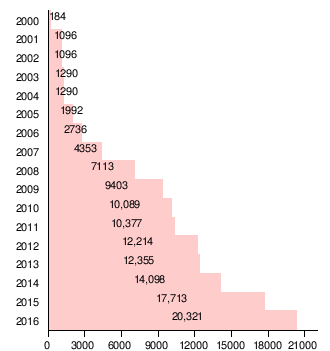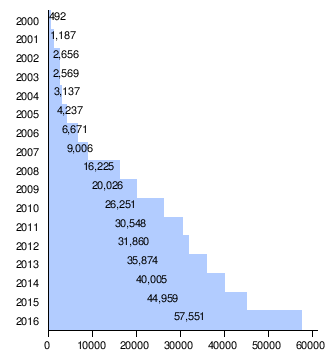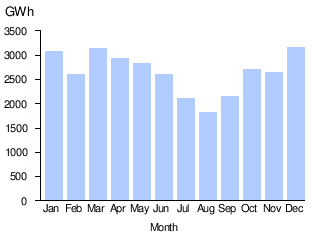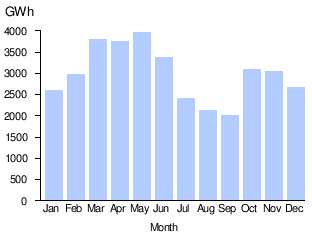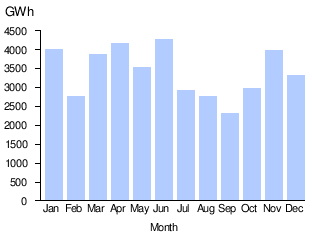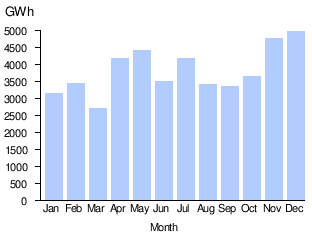Wind power in Texas
Wind power in Texas consists of many wind farms with a total installed nameplate capacity of 21,044 MW[1][2] from over 40 different projects. Texas produces the most wind power of any U.S. state.[3] Wind power accounted for 12.63% of the electricity generated in Texas in the 12 months ending Oct 2016.[1]
The wind resource in many parts of Texas is very large. Farmers may lease their land to wind developers, creating a new revenue stream for the farm. The wind power industry has also created over 24,000 jobs for local communities and for the state. Texas is seen as a profit-driven leader of renewable energy commercialization in the United States. The wind boom in Texas was assisted by expansion of the state’s Renewable Portfolio Standard, use of designated Competitive Renewable Energy Zones, expedited transmission construction, and the necessary Public Utility Commission rule-making.[4]
The Roscoe Wind Farm (781 MW), near the town of Roscoe, is the state's largest wind farm. Other large wind farms in Texas include: Horse Hollow Wind Energy Center, Sherbino Wind Farm, Capricorn Ridge Wind Farm, Sweetwater Wind Farm, Buffalo Gap Wind Farm, King Mountain Wind Farm, Desert Sky Wind Farm, Wildorado Wind Ranch, and the Brazos Wind Farm.
Overview
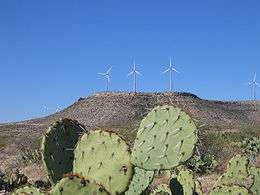
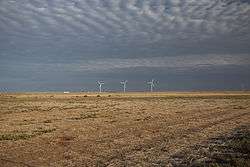

Wind power has a long history in Texas. West Texas State University began wind energy research in 1970 and led to the formation of the Alternative Energy Institute (AEI) in 1977. AEI has been a major information resource about wind energy for Texas.[5] The first 80-meter tower was erected at Big Spring, Texas in 1999.[6]
Several forces are driving the growth of wind power in Texas: favorable wind resources and land availability, State targets for renewable energy, cost efficiency of development and operation of wind farms, and a suitable electric transmission grid. The broad scope and geographical extent of wind farms in Texas is considerable: wind resource areas lie in the Texas Panhandle, along the Gulf coast south of Galveston, and in the mountain passes and ridge tops of the Trans-Pecos in the western tip of Texas. While there are over 10,700 wind turbines currently operating in Texas to generate electricity, there are still 80,000 windmills operating in Texas for pumping water, indicating the amount of growth potential still left for wind power generation.[7]
Wind power is a for-profit enterprise between land owners and wind farm operators. Texas farmers can lease their land to wind developers for either a set rental per turbine or for a small percentage of gross annual revenue from the project.[8] This offers farmers a fresh revenue stream without impacting traditional farming and grazing practices. Although leasing arrangements vary widely, the U. S. Government Accountability Office reported in 2004 that a farmer who leases land to a wind project developer can generally obtain royalties of $3,000 to $5,000 per turbine per year in lease payments. These figures are rising as larger wind turbines are being produced and installed.[9]
Wind power offers a reliability benefit in that its generation (though not its transmission) is highly decentralized. Sabotage and industrial accidents can be potential threats to the large, centrally located, power plants that provide most of Texas’ electricity. Should one of these plants be damaged, repairs could take more than a year, possibly creating power shortages on a scale that Texans have never experienced before. Coal trains and gas pipelines are also vulnerable to disruption. However, wind power plants are quickly installed and repaired. The modular structure of a wind farm also means that if one turbine is damaged, the overall output of the plant is not significantly affected.[10]
Wind is a highly variable resource. With proper understanding and planning, it can be incorporated into an electric utility's generation mix, although it clearly does not provide the sort of on-demand availability that Gas power stations provide.
Many areas in Texas have wind conditions allowing for development of wind power generation. The number of commercially attractive sites has expanded as wind turbine technology has improved and development costs continue to drop.[11] (→ Cost of electricity by source#United States) Particularly in southern Texas, the difference between land and off-shore air temperatures creates convection currents that generate significant winds during the middle of the day when electricity usage is typically at its peak level.[12] Although these winds are less than in West Texas, they occur more predictably, more in correlation with consumption, and closer to consumers. Several wind farms have been developed at the Texas coast, to a combined 3,000 MW.[13][14]
Starting in 2008, the wind power development boom in Texas outstripped the capacity of the transmission systems in place, and predicted shortages in transmission capability could have dampened the growth of the industry. Until 2008, the growth in wind power "piggybacked" on existing lines, but had almost depleted spare capacity.[15] As a result, in winter the west Texas grid often had such a local surplus of power, that the price would fall below zero.[16][17] According to Michael Goggin, electric industry analyst at AWEA, "Prices fell below US −$30/MWh (megawatt-hour) on 63% of days during the first half of 2008, compared to 10% for the same period in 2007 and 5% in 2006."[18]
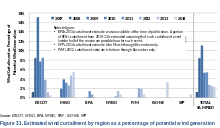
In July 2008, utility officials gave preliminary approval to a $4.9 billion plan to build new transmission lines to carry wind-generated electricity from West Texas to urban areas such as Dallas. The new plan would be the biggest investment in renewable energy in U.S. history, and would add transmission lines capable of moving about 18,000 megawatts.[19] ERCOT curtailed wind power by 17% (3.8 TWh) in 2009, but that decreased to only 0.5% by 2014, as transmission improved, particularly the Competitive Renewable Energy Zone (CREZ) in 2013.[20][21][22] However the CREZ lines are sometimes maxed out, and in November 2015, prices were negative for 50 hours. Wind power in Texas receives subsidies regardless of whether power prices are positive or negative. Wind power has occasionally supplied 14 GW in Texas, about half the consumption in the somewhat islanded state.[23][24][25]
In areas where Smart Metering is commonly installed,[26] some utilities offer free electricity at night.[27]
List of large wind farms in Texas
The table below lists the larger wind farms in Texas, currently operating or under construction. Wind farms which are smaller than 140 MW in capacity are not shown.
| Wind farm | Installed capacity (MW) | Turbine Manufacturer | County | Year |
|---|---|---|---|---|
| Brazos Wind Ranch | 160 | Mitsubishi | Scurry, Borden | |
| Buffalo Gap Wind Farm | 523 | Vestas | Taylor, Nolan | |
| Bull Creek Wind Farm | 180 | Mitsubishi | Borden | |
| Capricorn Ridge Wind Farm | 663 | GE Energy/ Siemens | Sterling, Coke | |
| Colbeck’s Corner Wind Farm | 200 | GE Energy | Carson, Gray | |
| Desert Sky Wind Farm | 160 | GE Energy | Pecos | |
| Goat Mountain Wind Ranch | 150 | Mitsubishi | Coke, Sterling | |
| Grandview Wind Farm | 211[30] | GE Energy | Carson | |
| Green Pastures | 300[31] | Acciona | Baylor, Knox | 2015 |
| Gulf Wind Farm | 283[32] | Mitsubishi | Kenedy | |
| Hackberry Wind Project | 165 | Siemens | Shackelford | |
| Hereford Wind | 200[33] | GE Energy/ Vestas | Deaf Smith | |
| Horse Hollow Wind Energy Center | 735 | GE Energy/ Siemens | Taylor, Nolan | |
| Inadale Wind Farm | 197 | Mitsubishi | Scurry/ Nolan | |
| Javelina Wind Energy Center | 250[34] | GE Energy | Webb | |
| Jumbo Road Wind | 300[35] | GE Energy | Castro | 2015 |
| King Mountain Wind Farm | 279 | Bonus/ GE Energy | Upton | |
| Langford Wind Farm | 150 | GE Energy | Tom Green, Schleicher, Irion | |
| Logan's Gap Wind | 200[36] | Siemens | Comanche | |
| Lone Star Wind Farm | 400 | Gamesa | Shackelford, Callahan | |
| Los Vientos Wind Farm | 912[37] | Starr, Willacy | ||
| Magic Valley Wind Farm | 203[38] | Willacy | ||
| McAdoo Wind Farm | 150 | GE Energy | Dickens | |
| Mesquite Creek Wind | 211[39] | GE Energy | Borden, Dawson | |
| Miami Wind Energy Center | 289[40] | GE Energy | Roberts, Hemphill, Gray and Wheeler | |
| Notrees Windpower | 150 | Ector, Winkler | ||
| Palo Duro Wind Energy Center | 250 | GE Energy | Hansford, Ochiltree | 2014 |
| Panhandle Wind (I & II) | 400 | GE/ Siemens | Carson | 2014 |
| Panther Creek Wind Farm | 458 | GE Energy | Howard, | |
| Papalote Creek Wind Farm | 380[41] | Siemens | San Patricio | |
| Peñascal Wind Farm | 404 | Mitsubishi | Kenedy | |
| Pyron Wind Farm | 249 | GE Energy | Scurry/ Fisher, Nolan | |
| Rattlesnake Wind Energy Center | 207[42] | GE Energy | Glasscock | 2015 |
| Roscoe Wind Farm | 781[43] | Mitsubishi | Nolan | |
| Shannon Wind | 204[44] | GE Energy | Clay | 2015 |
| Sherbino Wind Farm | 300[45] | Vestas | Pecos | |
| Stephens Ranch Wind (I & II) | 376[46] | GE Energy | Borden, Lynn | 2014, 15 |
| Sweetwater Wind Farm | 585 | GE Energy/ Siemens/ Mitsubishi | Nolan | |
| Trent Wind Farm | 150 | GE Energy | Taylor | |
| Turkey Track Energy Center | 170 | Nolan, Coke, Runnels | ||
| Wildorado Wind Ranch | 161 | Siemens | Oldham, Potter, Randall | |
| Woodward Mountain Wind Ranch | 159 | Vestas | Pecos |
Location map

Renewable Portfolio Standard
The Texas Renewable Portfolio Standard was originally created by Senate Bill 7 and signed by Governor Bush in 1999,[47][48][49] which helped Texas eventually become the leading producer of wind powered electricity in the U.S.[50][51][52] The RPS was part of new laws that restructured the electricity industry. The Texas RPS mandated that utility companies jointly create 2000 new MWs of renewable energy by 2009 based on their market share. In 2005, Senate Bill 20, increased the state’s RPS requirement to 5,880 MW by 2015, of which, 500 MW must come from non-wind resources. The bill set a goal of 10,000 MW of renewable energy capacity for 2025, which was achieved 15 years early, in 2010.[53]
According to DSIRE.org, "In 1999 the Public Utility Commission of Texas (PUCT) adopted rules for the state's Renewable Energy Mandate, establishing a renewable portfolio standard (RPS), a renewable-energy credit (REC) trading program, and renewable-energy purchase requirements for competitive retailers in Texas. The 1999 standard called for 2,000 megawatts (MW) of new renewables to be installed in Texas by 2009, in addition to the 880 MW of existing renewables generation at the time. In August 2005, S.B. 20 increased the renewable-energy mandate to 5,880 MW by 2015 (about 5% of the state's electricity demand), including a target of 500 MW of renewable-energy capacity from resources other than wind. Wind accounts for nearly all of the current renewable-energy generation in Texas. The 2005 legislation also set a target of reaching 10,000 MW of renewable energy capacity by 2025.[53]
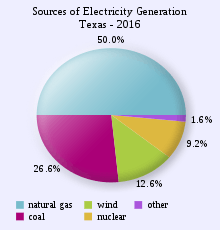
The schedule of renewable energy capacity required and the corresponding compliance dates are as follows:
- 2,280 MW by 1/1/2007
- 3,272 MW by 1/1/2009
- 4,264 MW by 1/1/2011
- 5,256 MW by 1/1/2013
- 5,880 MW by 1/1/2015
Qualifying renewable energy sources include solar, wind, geothermal, hydroelectric, wave or tidal energy, biomass, or biomass-based waste products, including landfill gas. Qualifying systems are those installed after September 1999. The RPS applies to all investor-owned utilities. Municipal and cooperative utilities may voluntarily elect to offer customer choice.
The PUCT established a renewable-energy credit (REC) trading program that began in July 2001 and will continue through 2019. Under PUCT rules, one REC represents one megawatt-hour (MWh) of qualified renewable energy that is generated and metered in Texas. A capacity conversion factor (CCF) is used to convert MW goals into MWh requirements for each retailer in the competitive market. The CCF was originally administratively set at 35% for the first two compliance years, but is now based on the actual performance of the resources in the REC-trading program for the previous two years. For the 2010 and 2011 the CCF will be 30.5%." Each retailer in Texas is allocated a share of the mandate based on that retailer’s pro rata share of statewide retail energy sales. The program administrator maintains a REC account for program participants to track the production, sale, transfer, purchase, and retirement of RECs. Credits can be banked for three years, and all renewable additions have a minimum of 10 years of credits to recover over-market costs. An administrative penalty of $50 per MWh has been established for providers that do not meet the RPS requirements.
Future developments
An energy storage system is being developed for West Texas. The system allows excess wind energy to be stored, making wind energy more predictable and less variable.[54] This 36 MW battery facility became operational in December 2012.[55]
The development of the Tres Amigas HVDC link to the Western grid and the Eastern grid will allow more flexibility in importing and exporting power to and from Texas.[56]
A 300 MW offshore wind farm is planned for Galveston, and 2,100 MW for the Gulf Coast of Texas.[57] Making turbines that are able to yaw quickly will make them more likely to be able to survive a hurricane.[58]
Statistics
|
|
| Texas Wind Generation (GWh, Million kWh) | |||||||||||||
|---|---|---|---|---|---|---|---|---|---|---|---|---|---|
| Year | Total | Jan | Feb | Mar | Apr | May | Jun | Jul | Aug | Sept | Oct | Nov | Dec |
| 2013 | 35,874 | 2,601 | 2,977 | 3,802 | 3,760 | 3,966 | 3,386 | 2,406 | 2,133 | 2,023 | 3,093 | 3,057 | 2,670 |
| 2014 | 40,005 | 4,003 | 2,763 | 3,872 | 4,178 | 3,535 | 4,282 | 2,912 | 2,764 | 2,320 | 2,981 | 3,994 | 3,322 |
| 2015 | 44,959 | 3,164 | 3,442 | 2,715 | 4,195 | 4,428 | 3,528 | 4,191 | 3,415 | 3,382 | 3,659 | 4,792 | 4,990 |
| 2016 | 57,624 | 4,464 | 5,143 | 5,649 | 4,751 | 5,097 | 3,860 | 5,675 | 3,713 | 3,923 | 5,473 | 4,513 | 5,363 |
|
|
|
|
See also
References
- 1 2 AWEA Texas Fact Sheet (03 April 2017)
- ↑ http://www.utilitydive.com/news/utility-wind-rush-set-to-strengthen-as-low-prices-allow-resource-to-spread/437409/
- 1 2 AWEA Third Quarter 2012 Market Report
- ↑ Lauren Glickman (25 August 2011). "Stetsons Off to Gov. Perry on Wind Power". Renewable Energy World.
- ↑ "Alternative Energy Institute".
- ↑ "Turbine timeline: The History of AWEA and the U.S. Wind Industry: 1990s." American Wind Energy Association. Retrieved 24 November 2015. AWEA website
- ↑ Roping the Breezes
- ↑ Krauss, Clifford (2008-02-23). "Move Over, Oil, There’s Money in Texas Wind". The New York Times. Retrieved 2008-11-05.
- ↑ State Energy Conservation Office. The New Cash Crop
- ↑ SEED Coalition and Public Citizen’s Texas office (2002). Renewable Resources: The New Texas Energy Powerhouse p. 11.
- ↑ "Texas Wind Energy Resources".
- ↑ "Texas Is Too Windy and Sunny for Old Energy Companies to Make Money". Bloomberg.com. 2017-06-20. Retrieved 2017-06-23.
- ↑ Handy, Ryan Maye (2017-07-27). "Sea change: Gulf Coast wind farms become vital to Texas energy mix". Houston Chronicle. Retrieved 2017-07-31.
- ↑ "Duke Energy Renewables completes the final Los Vientos wind project in Texas | Duke Energy | News Center". News.duke-energy.com. 2016-08-03. Retrieved 2017-02-28.
- ↑ USA Today: Lines lacking to transmit wind energy.
- ↑ Giberson, Michael (28 January 2009). "UPDATED: Negative power prices in the West region of ERCOT in 2008". Knowledge Problem. Retrieved 2009-03-01.
- ↑ Wang, Ucilia (10 December 2008). "Texas Wind Farms Paying People to Take Power". Greentech Media. Retrieved 2012-11-23.
- ↑ Goggin, Michael (19 September 2008). "Curtailment, Negative Prices Symptomatic of Inadequate Transmission". Renewable Energy World. Retrieved 2009-03-01.
- ↑ Texas Will Spend Billions on Transmission of Wind Power
- ↑ Wiser, Ryan H., and Mark Bolinger. "2014 Wind Technologies Market Report" page 38. Lawrence Berkeley National Laboratory, August 2015.
- ↑ Wiser, Ryan H., Eric Lantz, Mark Bolinger, and Maureen M. Hand. "Recent Developments in the Levelized Cost of Energy from U.S. Wind Power Projects" page 12. Lawrence Berkeley National Laboratory, 2012. Header page
- ↑ http://www.puc.texas.gov/industry/maps/maps/CREZ_Map_Attach_A.pdf
- ↑ Naureen Malik,Harry Weber (5 April 2016). "One Thing California, Texas Have in Common Is Negative Power". Bloomberg.com. Retrieved 17 April 2016.
- ↑ "The What, When And How of Texas Electricity Prices Going Negative". CleanTechnica. 1 October 2015. Retrieved 17 April 2016.
- ↑ "Scope of Competition in Electric Markets in Texas" (PDF). Public Utility Commission of Texas. Retrieved 11 February 2015.
- ↑ CLIFFORD KRAUSS and DIANE CARDWELL (8 November 2015). "A Texas Utility Offers a Nighttime Special: Free Electricity".
- ↑ AWEA 3rd Quarter 2008 Market Report
- ↑ Texas Renewable Energy Industries Association. Texas operational wind plants
- ↑ http://www.newschannel10.com/story/32300756/grandview-wind-farm-under-new-ownership
- ↑ http://www.power-technology.com/projects/green-pastures-wind-project-texas/
- ↑ http://pepei.pennnet.com/display_article/336467/6/ARCHI/none/INDUS/1/Babcock-&-Brown-Gulf-Coast-wind-project-clears-legal-hurdle/
- ↑ http://nawindpower.com/edf-renewable-energy-dedicates-hereford-wind-with-blackrock-infrastructure
- ↑ http://www.nexteraenergyresources.com/pdf_redesign/Javelina.pdf
- ↑ http://www.lincoln-clean-energy.com/projects/
- ↑ http://www.windpowerengineering.com/construction/projects/logans-gap-wind-facility-in-texas-is-now-fully-operational/
- ↑ http://www.powermag.com/press-releases/duke-energy-renewables-completes-the-final-los-vientos-wind-project-in-texas/
- ↑ https://www.eon.com/en/media/news/press-releases/2014/11/28/eon-sells-interest-in-650-million-value-wind-portfolio-to-enbridge-inc.html
- ↑ http://www.windpowerengineering.com/construction/projects/duke-energy-acquires-50-stake-in-texas-mesquite-creek-wind-farm/
- ↑ http://nawindpower.com/invenergys-miami-wind-energy-center-goes-live-in-texas
- ↑ 196 Wind Turbines Cranking Out Power
- ↑ http://nawindpower.com/invenergys-rattlesnake-producing-power
- ↑ E.ON Delivers 335-MW of Wind in Texas
- ↑ http://nawindpower.com/204-mw-shannon-wind-farm-goes-online-in-texas
- ↑ Sherbino II Online
- ↑ http://starwoodenergygroup.com/wp-content/uploads/2015/06/Starwood-Energy-Groups-Stephens-Ranch-Wind-Project-Phase-II-becomes-Operational.pdf
- ↑ SB7 Law textTexas Legislature Online, May 1999. Retrieved September 24, 2011.
- ↑ "Texas Renewable Portfolio Standard". Texas State Energy Conservation Office. Retrieved September 24, 2011.
- ↑ "Texas Renewable Portfolio Standard". Pew Center on Global Climate Change. September 24, 2011. Archived from the original on April 27, 2012.
- ↑ Koronowski, Ryan. It's Not Just Oil: Wind Power Approaches 8% of Texas Electricity in 2010 Repower America', January 19, 2011. Retrieved September 24, 2011.
- ↑ Galbraith, Kate and Price, Asher (August 2011). "A mighty wind". Texas Monthly. p. 5. Archived from the original on March 2, 2014. Retrieved February 26, 2014.
- ↑ "Swift Boats and Texas Wind". Windsector.tumblr.com. July 28, 2011. Archived from the original on January 18, 2012. Retrieved July 31, 2012.
- 1 2 Amory B. Lovins (2011). Reinventing Fire. p. 218.
- ↑ West Texas Project Could Change Future of Wind Power
- ↑ Duke Energy. "Duke Energy Renewables completes Notrees Battery Storage Project in Texas; North America's largest battery storage project at a wind farm". Duke Energy. Retrieved 28 June 2015.
- ↑ Tres Amigas
- ↑ Texas Offshore Wind Project Eyes Test Turbine by End of 2011
- ↑ Wind Turbines Can Be Strengthened Against Hurricanes
- ↑ "AWEA Fourth Quarter 2016 Market Report". American Wind Energy Association. January 26, 2017. Retrieved March 9, 2017.
- ↑ "Generation Annual". U.S. Department of Energy. July 10, 2012. Retrieved August 6, 2012.
- ↑ "U.S. EIA, Electric Power Monthly". U.S. Department of Energy. February 25, 2017. Retrieved March 10, 2017.
- ↑ EIA (July 23, 2013). "Electric Power Monthly Table 1.17.A.". United States Department of Energy. Retrieved 2013-07-23.
- ↑ EIA (July 23, 2013). "Electric Power Monthly Table 1.17.B.". United States Department of Energy. Retrieved 2013-07-23.
External links
| Wikimedia Commons has media related to Wind power in Texas. |
- Compressed air storage
- Actual and predicted wind power
- Wind Power Helps Texas Move Past Oil
- Texas oil tycoon plans largest wind farm
- Wind power experts say Texas grid needs work
- Wind energy in Texas – Reasons for success
- Head, Christopher (February 9, 2011). "The Curious Case of the Texas Wind Industry". The Energy Collective. Retrieved 2011-02-10.
- Every wind farm of Texas @The Wind Power
- ERCOT Forecasted and Actual Wind Power Production


